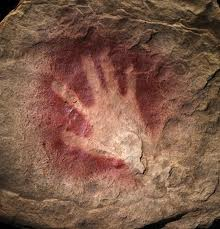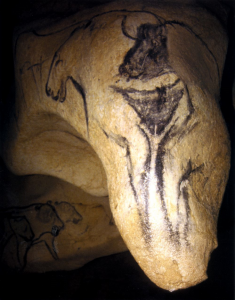Werner Herzog’s Cave of Forgotten Dreams
I just watched Herzog’s 3-D Cave of Forgotten Dreams, although I opted not to see in 3D. In 1994, three speleologists found the cave that had been hermetically sealed for 20,000 years by a fallen rock face. Named Grotte Chauvet, after one of the discoverers Jean-Marie Chauvet, the cave contains 32,000 year old perfectly preserved paintings of horses, bison (in Europe?!), lions (the males had no manes back then!), panthers, bears, owls, hyenas, rhinos, and some abstract symbols. Whoever painting these images (the “artist,†as Herzog repeatedly likes to refer to him/her), and for whatever purpose, worked with the contours of the cave’s walls expertly, and even to suggest the illusion of movement (a kind of “proto-cinema†says Herzog).
There are also several red handprints at the entrance to the cave and deeper into it. They seem to belong to someone with a crooked pinky finger, the reason why we can conclude both sets of prints came from the same person. Is he (or she, although in the film scientists and filmmaker alike unproblematically refer to a “he,†until someone calls them on it) beckoning us, guiding us, or perhaps warning us not to enter? I would have liked to know the nature of the red paint (blood?), but the film does not speculate on this, at least that I can remember.


There are no human figures, with the exception of one in one of the deepest areas of the cave: what looks to be a human/animal hybrid figure, a woman from the pubic triangle down to the legs, with a bison head. Or, perhaps woman and bison are superimposed on one another to suggest some kind of spiritual connection, as they seem to share a leg and the head of the bison seems to be overlaid on her belly. The paintings, and this one in particular, invite contemplation about the human/nature connection, which Herzog freely indulges in, including in a strange postscript to the film featuring albino crocodiles (I don’t want to spoil it for those who have not seen it). As Jean Clottes, the scientist who conducted the verification visit when the cave was discovered, posits: “The paleolithic world was suffused with fluidity and permeability . . . . there were no barriers between man and animal.â€
As is to be expected in response to such a discovery, Herzog, the scientists and art historians involved in the study of Chauvet, and I, cannot help but indulge in the construction of narratives and projections about these images, in an attempt satisfy what is perhaps a universal human need for meaning. As I contemplate the possible meanings of and reasons for these images, I note the striking contrast between the ubiquity and visibility of images today, and the care with which the images in Chauvet seem to have been drawn and kept hidden. There is no evidence that humans lived in the cave (no human bones were found, but there were plenty of bear bones and skulls).
And in searching for meaning, of the paintings, of Herzog’s film, of what it means to represent, I recall a passage in Herzog on Herzog where, like the red handprints, Herzog may be beckoning us and pointing the way:
“I have often spoken of what I call the inadequate imagery of today’s civilization. I have the impression that the images that surround us today are worn out; they are abused and useless and exhausted. They are limping and dragging themselves behind the rest of our cultural evolution. When I look at the postcards in tourist shops and the images and advertisements that surround us in magazines or I turn on the television, or if I walk into a travel agency and see those huge posters with that same tedious image of the Grand Canyon on them, I truly feel there is something dangerous emerging here.
[. . . ] As a race we have become aware of certain dangers that surround us. We comprehend, for example, that nuclear power is a real danger for mankind, that over-crowding of the planet is the greatest of all. We have understood that the destruction of the environment is another enormous danger. But I truly believe that the lack of adequate imagery is a danger of the same magnitude. It is as serious a defect as being without memory. What have we done to our images? What have we done to our embarrassed landscapes? I have said this before and will repeat it again as long as I am able to talk: if we do not develop adequate images we will die out like dinosaurs [. . .]
We need images in accordance with our civilization and our innermost conditioning, and this is the reason why I like any film that searches for new images no matter in what direction it moves or what story it tells. One must dig like an archaeologist and search our violated landscape to find anything new. It can sometimes be a struggle to find unprocessed and fresh images.â€
http://movies.nytimes.com/2011/04/29/movies/werner-herzogs-cave-of-forgotten-dreams-review.html
http://www.slate.com/id/2292498/
http://www.showcaves.com/english/fr/caves/Chauvet.html



Paula,
Fluidity and permeability are not always invited by Herzog’s film’s, in fact, he’s often spoken of barriers between humanity and nature and his vision of nature as a reflection of human psychology. I’m excited to see how the film visually and aurally invites permeability and perhaps will see it in 3D if it ever makes it to Oregon. Great review.
Nice thoughts here! You might also explore this film in relation to *Lessons of Darkness* (1992). Lessons of Darkness uses images from the same Gulf War and the fires erupting after it to create a multi-genre fifty-four minute film that is part documentary and part science fiction.
In this documentary, Herzog creates a meditation on the nature of the spectacle that he encountered as an “outsider,†a “visitor†sensitive to the environmental destruction, but he also takes the time to explore intimate details of Kuwaiti citizens who have been brutalized by the Iraqi invasion.
Lessons of Darkness gives us the scale of the distance between the oil wells that are burning and emphasizes the utter darkness caused by smoke from the fires, a smoke so thick the sun is blacked out, showing such powerful spectacle that it demonstrates well Philip Roth’s quote, “The actuality is continuously outdoing our talents.†The epigraph from Blaise Pascal that opens Herzog’s film helps illustrate how devastating fires might take on the role of spectacle: “The collapse of the stellar universe will occur like creation—in grandiose splendor.â€
You might also check out our blog, http://ecocinema.blogspot.com/
Cheers!
Robin
I also thought The Cave was outstanding. And I’m going to put in my plug to SEE IT IN 3D! I have almost no interest in the 3D phenomenon, but to see the perspective of the painters’ uses of three-dimensional space as cave walls fold and/or open onto recesses, the visual effect is most helpful.
What did people think of the “Postscript?”
I admit, at first I felt like I was watching the filmmaker’s equivalent of those few texts you just cannot leave out of your dissertation even though they just do not fit. But, later, I really appreciated the way the P.S. brought me back to the film a lot, trying to discern what Herzog was saying within this portion of the film and how it refracted the rest of the film’s structure, which I found brilliant. My take is that Herzog astutely avoided a straightforward, easy-to-swallow didacticism that allows us to watch a film, feel appropriately bad about ecological crises, and then go home satisfied at having felt bad. Instead, he makes us think about what we will take away from the film.
Keen to hear others’ thoughts.
Andrew, I’m take the liberty of pointing you to Erika Berroth’s article, “Animals, Landscapes and Humans in the Work of Werner Herzog: Developing Epistemologies in Docu-Fiction Eco-Cinema,” submitted to the ASLE seminar. It gets at the P.S. a bit, as I think does Adrian’s post on his Immanence blog.